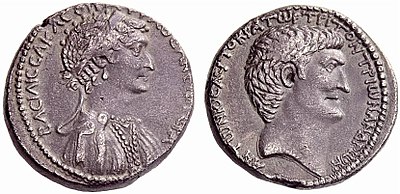Allégorie de la province romaine d'Afrique - Grand Palais, Paris 2014
The following quotation and assessment comes from Walker, Susan; Higgs, Peter (2001). Cleopatra of Egypt: From History to Myth. Princeton, N.J.: Princeton University Press. ISBN 9780691088358, pp 312-313:
Conspicuously mounted on the cornucopia is a gilded crescent moon set on a pine cone. Around it are piled pomegranates and bunches of grapes. Engraved on the horn are images of Helios (the sun), in the form of a youth dressed in a short cloak, with the hairstyle of Alexander the Great, the head surrounded by rays... The symbols on the cornucopia can indeed be read as references to the Ptolemaic royal house and specifically to Cleopatra Selene, represented in the crescent moon, and to her twin brother, Alexander Helios, whose eventual fate after the conquest of Egypt is unknown. The viper seems to be linked with the pantheress and the intervening symbols of fecunditity rather than the suicide of Cleopatra VII. The elephant scalp could refer to Cleopatra Selene's status as ruler, with Juba II, of Mauretania. The visual correspondence with the veiled head from Cherchel encourages this identification, and many of the symbols used on the dish also appear on the coinage of Juba II.
The following quotation and assessment comes from Roller, Duane W. (2003), The World of Juba II and Kleopatra Selene: Royal Scholarship on Rome's African Frontier, New York: Routledge, ISBN 9780415305969, pp. 141-142:
No certain portraits of Kleopatra Selene have been found at Caesarea, although the two pieces noted above may be the queen. A bone counter in the British Museum...shows the left-facing bust of a woman...with curls remindful of portraits of Kleopatra VII, but the piece has been suggested to be her daughter...More significant is a gilded silver dish in the Louvre, part of the collection found at Boscoreale in 1895...[It] has the figure of a woman depicted in high relief. Her features are remindful of those of Kleopatra VII, but are not the same. On her head is the scalp of an elephant; on one breast is an asp and on the other a panther. To her left is a cornucopia with Helios engraved as a young man. On her right shoulder is a lion. The piece has a complex visual symbolism that points consistently to a North African context, with the cornucopia and lion especially remindful of the coinage of the Mauretanian monarchs. The suggestion that it is a portrait of Kleopatra Selene has much merit.
Relevante Bilder
















Relevante Artikel
Kleopatra VII.Kleopatra VII. Philopator herrschte als letzte Königin der makedonisch-griechischen Dynastie der Ptolemäer von 51 v. Chr. bis 30 v. Chr. über Ägypten. In den ersten vier Jahren regierte sie zunächst gemeinsam mit ihrem Bruder Ptolemaios XIII., der 47 v. Chr. im Alter von 14 Jahren starb, später mit anderen männlichen Mitregenten, da unter der Garantie Roms gesetzliche Regelungen eine Doppelbesetzung des Thrones vorsahen. .. weiterlesen
